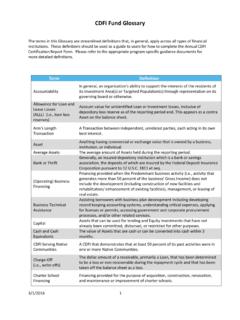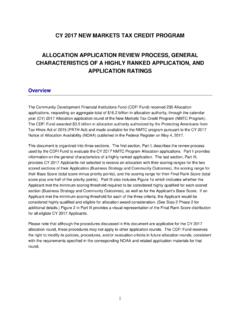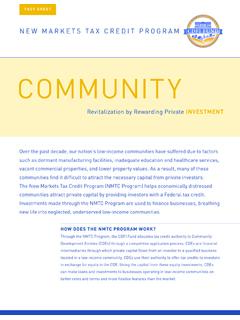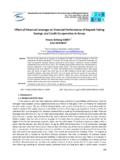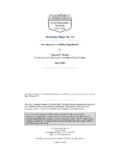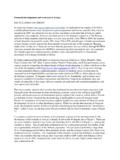Transcription of CDFI Industry Analysis Summary Report
1 SPRING 2012 CDFI Industry AnalysisSummary ReportMICHAEL SWACK, JACK NORTHRUP, AND ERIC HANGENB ackgroundThe Carsey Institute, under contract to NeighborWorks America and the Department of Treasury s Community Development Financial Institutions (CDFI) Fund, conducted a detailed Analysis of a large sample of community development financial institutions (CDFIs) on issues of capitalization, liquidity and portfolio, and risk management by CDFIs from 2005 to 2010. This work is part of the CDFI Fund s Capacity Building Initiative. The purpose of the Report is to explore issues of capital-ization, liquidity, and portfolio and risk management by CDFIs. This study involved a large sample of CDFIs. However, at least for CDFI Loan Funds, it was a selected Analysis . It is important to note that the Analysis is not necessarily representative of all CDFI Loan Funds;2 but it is representative of CDFI Banks, CDFI Credit Unions and CDFI Bank Holding companies, as information obtained is from all institutions with CDFI fill a market gap by supplying financial products and services tailored to the needs of underserved communities and are targeted to pro-mote community development.
2 CDFIs may take the form of loan funds, credit unions, banks, holding companies, and venture funds within the finance/insurance/real estate Industry sector. As of November 30, 2010, there were approximately 907 certified CDFIs in operation in the United States, including 572 nonprofit loan funds, 197 credit unions, 72 CDFI banks, 41 bank holding companies, and 25 venture is a distinction between a CDFI and the CDFI Fund. The CDFI Fund provides certification to CDFIs that meet the six statutory and regulatory criteria of the CDFI 1 Industry Overview 2 Caveats and Limitations 3 Primary Findings 4 Policy Recommendations 14 Conclusion 17 Appendix: Summary Statistics 18 Key Findings CDFIs have been stepping into the breach to address lending-related needs during the recession and have paid a financial price for doing so.
3 CDFI portfolio performance has been mixed, but only for a minority of organizations is it an issue that significantly affects overall financial performance. Significant scale effects exist in all sectors of the CDFI Industry . Operating expenses play the driving role in determining whether CDFIs achieve self-sufficiency. CDFIs, particularly CDFI Loan Funds, face numerous barriers preventing them from using and leveraging capital more OverviewThe research focused on the following questions:1. What capitalization and liquidity issues do CDFIs face?2. What portfolio health and risk-management issues do they face?3. What factors affect CDFI self-sufficiency?4. How have CDFIs been affected by the recession of 2008-2009?5. Given that CDFIs vary greatly along a spectrum of types, sizes, financial products, etc.
4 , how are the various players affected by the issues?6. How do these issues impact CDFIs versus traditional financial entities that share similar characteristics ( , CDFI banks vs. traditional banks of a similar size)?To explore these questions, data from multiple sources was compiled and analyzed, including:1. Financial reports submitted to regulators by CDFI banks and credit unions, and their traditional counterparts, in Data submitted by nonprofit CDFI Loan Funds to the CDFI Fund when applying to the CDFI Program, including audited financial statements, self-reported financial and loan portfolio metrics, and detailed business plans. Generally these applications yielded data from the year ending in Data from 80 CDFI senior executives surveyed in Community Investment Impact System (CIIS) data compiled by the CDFI Fund from a limited number of CDFIs in Interviews with 13 Industry stakeholders, which were used to organize the research and to present preliminary research findings for further 1 provides a breakdown of the groups studied.
5 Table 1: Breakdown of study groupsNumber in IndustryCDFIs in industryCDFIs examined in this studyLoan funds?572282 Credit unions7,503~1974197 Banks6,838~7272 Bank holding companies3,984~4641 Venture funds462525- 2 CDFI FUND AND CARSEY INSTITUTEC aveats and LimitationsAll of the themes and findings raised in these reports should be treated as working hypotheses supported by existing data, but that may merit additional data gathering and research. The Analysis is limited by a number of The institutional CDFI certification was not time stamped. In the case of CDFI Loan Funds, each organization is a certified CDFI for all reporting years. The same cannot be said for banks, holding companies, and credit unions. For these institutions, the CDFI Fund s published listing of 907 certified CDFIs as of November 30, 2010 was referenced.
6 Data from 2005-2010 are included for any bank, bank holding company, or credit union that is listed as a certified CDFI whether or not it was a certified CDFI during this For CDFI Loan Funds, self-reported CDFI application data on organizational financials and loan portfolio perfor-mance was used. This data is somewhat dated, and because loan funds are not regulated, there are no standards beyond the guidance provided by application instructions. Audited financial information was used for the loan funds studied in more detail, but even here auditors for the selected CDFIs used vastly different reporting practices. This limitation is so significant that it is included as one of the main findings of this Uniform Bank Performance Reports (UBPR) data sets are used for bank analyses. The data sets are somewhat aggre-gated by Venture fund information is not included.
7 The researchers were unable to locate public sources of data for CDFI venture capital firms. 5. The Analysis focuses largely on financial metrics as opposed to social metrics. However, if a CDFI fails to achieve an attractive business return, it does not necessarily mean that it fell short of important mission returns. 6. This study did not attempt to address a range of issues which affect the field and were often raised in interviews. For example, the mission impacts of CDFIs are worthy of a more exhaustive study than was conducted here. Addition-ally, many interviewees cited the difficulty of attracting and retaining staff members with financial Industry knowl-edge and experience. CDFI FUND AND CARSEY INSTITUTE 3 Primary FindingsThe five key findings of the Report are as follows:Finding 1: CDFIs have been stepping into the breach to address lending-related needs during the recession and have paid a financial price for doing have expanded their assets and their loan portfolios since the market peak in 2005, as the economic crisis has made it harder to access traditional credit Among loan funds in this sample, median assets doubled and loan portfolios increased 76 percent.
8 The median CDFI loan fund deployment ratio grew percent annually from 2006 to CDFI credit union portfolios grew faster than their traditional counterparts from 2005 through 2010. The median CDFI credit union portfolio grew 47 percent from 2005 to 2010, compared with 29 percent growth for non-CDFI credit unions. Assets grew by 38 percent, compared with 47 percent for non-CDFI credit unions. In an apparent response to the mort-gage credit crisis, CDFI credit unions also appear to be shifting their portfolio composition, in particular by increasing their focus on first mortgages from 18 percent of loans in 2005 to 26 percent of loans in CDFI banks saw median assets grow at an annualized rate of percent from 2006 to 2010, while the assets of corre-sponding traditional banks grew at an annualized rate of percent.
9 CDFI banks saw their median loan portfolios grow 33 percent over the same period, versus 27 percent for the comparison Analysis of selected CDFI business plans confirms that CDFIs are willing to take risks and serve customers with financial products that traditional capital markets are unlikely to provide. As described in their business plans, business lending CDFIs are making start-up loans, micro-enterprise loans, and providing gap financing, or focusing their lending on minority and/or low-income borrowers in distressed areas. CDFIs that focus on mortgages and other housing-related loans are focusing their products on traditionally underserved populations such as low-income and minority households, and providing low-cost prod-ucts including home purchase loans, foreclosure prevention loans, emergency loans for seniors, and energy efficiency loans.
10 Real estate development CDFIs are lending to developers serving low- and very-low-income populations, not only for development of affordable housing but also for community facilities, retail outlets and charter schools, among other short, true to their mission, CDFIs appear to be stepping into the breach to attempt to close gaps faced by constituents who cannot access traditional market the same time, CDFIs appear to have paid a financial price for their actions during the recession:1. CDFI credit unions have experienced declining earnings and rising delinquency rates, and they have higher delinquency rates than the credit union Industry as a whole. Net income has declined every year from 2008 to 2010; return on assets declined every year from 2006 to 2010; and net interest margin declined every year from 2005 to 2010.



